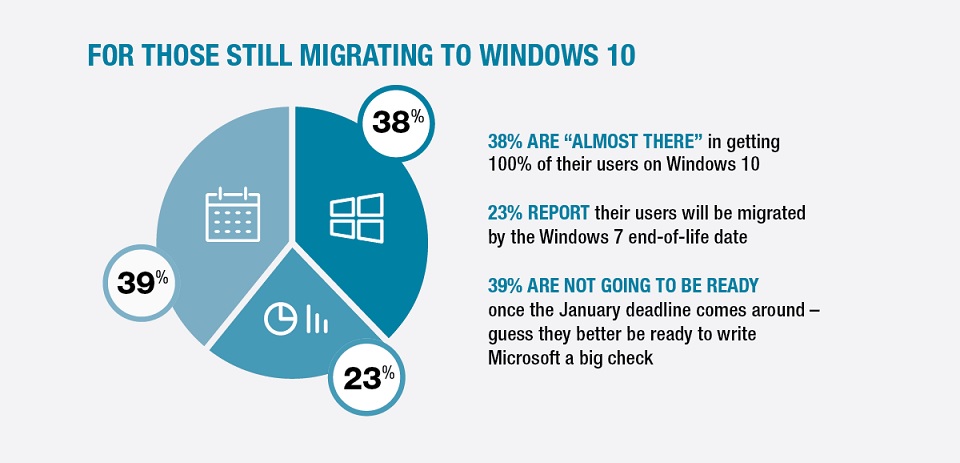
For IT professionals responsible for upgrading users to Windows 10, it's crunch time.
End of regular support for Windows 7 is nearly here (January 14, 2020) but as many as 59% say that only a portion of their users have been migrated to Windows 10. This is according to a new survey from Ivanti which includes responses from more than 500 IT professionals. Consider these key findings:
2 in 5 Organizations May be Writing a Big Check
Just 39% report that they have completed Windows 10 migration for all of their users. For those still migrating, 38% say they "almost" have 100% of their users on Windows 10, while 23% report that their users will be migrated by the Windows 7 end-of-life date. That leaves nearly two in five organizations (39%) that will not be ready when the January deadline hits – a risky and costly proposition!

As Microsoft has announced, after January 14, any PCs operating Windows 7 will become more vulnerable to security risks and viruses because new security updates will no longer be available from Microsoft. To avoid this, Microsoft does offer options for extended support, but the cost can be as high as $200 per Windows 7 PC for just one year's worth of OS security updates.
Fear that Updates May Break Applications
So, with high costs looming, and the fear of security risk mounting, why hasn't everyone completed their migration? The Ivanti Survey found that high resource and time requirements as well as migration costs (57%) were the top factor preventing the completion of Windows 10 migrations. The need to focus on other, higher IT priorities (47%) was the next most common factor while the fear of application readiness or support for Windows 10 (40%) followed as a close third.
In fact, application compatibility concerns are high across the board, preventing many organizations from performing needed software updates. Fear that new updates and patches will "break" applications was reported by 58% of respondents, while 48% don't want updates and patches to impact user productivity and 29% say updates and patches are too manually time consuming.
Costs to Maintain Windows 10 Expected to Be the Same, or Lower
Even though many organizations are still not prepared, the Windows 7 end-of-life date in January was the top priority driving the timing for those that have migrated to Windows 10 (44%). Other priorities driving the timing for a Windows 10 migration included the mitigation of security risk (23%), mitigation of operational risk (11%) and improving user productivity (10%).
The cost of maintaining Windows 10 compared to Windows 7, however, was not a factor. As many as half expect the cost of maintaining Windows 10 to be the same as Windows 7, with 20% even expecting maintenance costs to be lower.
Physical Still Far Outweighs Virtual
The lack of a significant maintenance cost impact for Windows 10 may be working to retain the use of physical devices, compared to the use of virtual or cloud-delivered workspaces for Windows 10. Even with Microsoft's recent focus on promoting Azure-delivered cloud workspaces and Windows Virtual Desktop, 70% of IT professionals still say they will use Windows 10 on physical desktops and laptops, while only a quarter expect to use a hybrid mix of virtual and physical desktops.
Automation to the Rescue
To avoid paying expensive support fees after the January deadline, companies may want to look to tools to help automate their migration, patching and update processes. This can dramatically relive IT from migration resource and time demands while minimizing cost and ensuring seamless support for user applications.


